

(June 2012) Today’s municipal market, in many ways, remains uncharted territory. In the past few years, it has seen liquidity challenges, the demise of the bond insurers and headline-grabbing fiscal struggles among state and local issuers of municipal debt. Looking forward, the market must contend with the inevitable implications of federal austerity measures.
Tax-backed (or tax-supported) debt, which accounts for some 60% of the municipal marketplace, traditionally has been free from much of the default pressure that has plagued corporate bonds and some of the riskier sectors of the municipal market. Today, the slow recovery and continued weakness in housing are affecting even this historically safe sector.
At BlackRock®, we understand that it’s a new world of investing. Today’s municipal market is decidedly different—given that the entire economy and every financial market has only recently weathered the worst economic and financial crisis in the post-WWII era—but most certainly manageable. Where others see risk, we see opportunity.
The key is careful credit research.
Credit Research: More Critical Than Ever
The municipal bond market clearly is not the same as it was 10 or even five years ago. In the past, investors could make a credit assessment simply by looking at traditional data, such as fund balances and debt per capita, to determine whether an issuer could pay its debt obligations. Today, investors need to question whether municipalities are solvent and willing to take meaningful action to pay their bills. As state and local governments continue to face fiscal challenges, BlackRock analysts are digging deep to understand the issuing government in its entirety, including its liquidity status and its approach to liability management. How will municipalities budget for future pension and retiree healthcare obligations as well as present-day debt service?
In the wake of the “Great Recession,” state and local governments continue to encounter budget shortfalls as the tax revenues (income, sales and property) required to fund operations remain pressured. Increasingly, states are offloading costs to local governments, which, in turn, have been challenged to maintain fiscal stability. Declining or stagnant home values continue to weaken property tax collections, which currently support the bulk of local government operations. As some of the more vulnerable municipalities struggle to remain solvent, the question among market participants is whether they will be able to continue paying debt service on their bonds.
The current situation is complicated by changes related to municipal bond insurance. Prior to the credit crisis and the demise of the monoline insurers, investors could rely on insurance to enhance the value of their bonds. At its peak, some 60% of new issues came to market insured; less than 10% are backed by insurance now. Today, we are also seeing some headline risk related to the insurers’ weak underwriting standards.
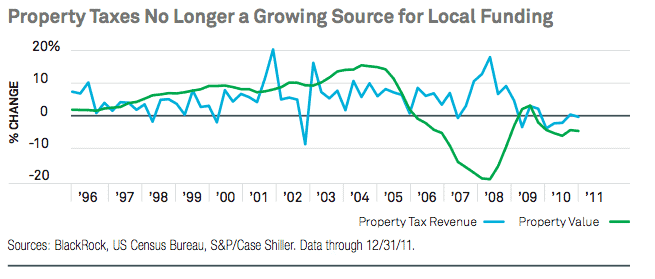
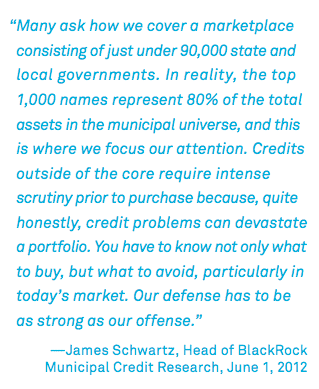
prior to the market peak. Some insurers had underwritten risky real estate projects. Fast forward to 2012 and some distressed local issuers are viewing that insurance as a liquidity backstop, giving them the option not to pay their debt service while they renegotiate with their creditors. The upshot is that bond insurance has little value today. For the most part, bonds are rated based solely on their underlying fundamentals, leaving investors with the onerous task of assessing the creditworthiness of a large number of bonds that were previously insured. Clearly, careful third-party credit analysis is integral for discerning value in today’s municipal marketplace.
Industry Experts
The importance of credit analysis at BlackRock is evident in the composition of the Municipal Credit Research Team. The team consists of 16 analysts assigned by geographic region and sector. With an average of 16 years’ experience, the analysts engage in top- down sector analysis and bottom-up security analysis to provide BlackRock portfolio managers with the intelligence to make informed investment decisions for client portfolios.
BlackRock analysts are widely recognized as industry experts and maintain strategic relationships with municipal market participants across the country. Analysts visit project sites, speak with officials and developers and, as needed, hire consultants to evaluate projects pre-construction to assess soundness and, as such, investment viability. They share information so that the group as a whole better understands local economic and financing trends as well as fundamental developments within the various municipal revenue sectors.
Internal Credit Assessment and Rating System
In evaluating potential investments, BlackRock analysts do not rely on the ratings assigned by the big-three credit rating agencies—Moody’s, S&P and Fitch. While analysts will closely monitor and reference the agencies’ ratings, they are essentially tasked with challenging them, seeking information above and beyond the content in the rating agency reports in an effort to ensure that BlackRock’s municipal portfolios are populated with the strongest, most suitable credits. Importantly, these internal ratings are not static. Bonds are revisited frequently and, when applicable, changes are made to the internal credit assessment.
BlackRock’s internal credit ratings system is multi-dimensional and exceptionally thorough. Top-down sector and geographic preferences help to inform the intensive bottom-up process used for researching and rating municipal bonds. Research team findings are published daily, as credits are assessed, and made available to all BlackRock municipal bond portfolio managers. BlackRock analysts are able to effectively track a comprehensive cross-section of the municipal marketplace.

The BlackRock Difference
Ongoing Surveillance. Risk management is daily work at BlackRock, intricately woven into the investment management process. It should come as little surprise then that our municipal credit research capability is distinct from the rating agencies’ and competitors’ processes in many ways. Among them:
Dedicated municipal credit research team. As noted earlier, BlackRock has a robust team dedicated exclusively to municipal credit research. This is a unique characteristic in an asset manager.
Market leadership. As the largest manager of municipal assets, BlackRock has access to opportunities that individual investors and other asset managers may not. Our municipal credit analysts have relationships with dealers and local governments that are unmatched in the marketplace.
Cutting-edge technology. BlackRock analysts have access to state-of-the-art technology that is integrated into all steps of the research and portfolio management process.
Assessment of ability and willingness to pay debt. While quantitative models are used by both the rating agencies and BlackRock to assess bonds, the models are more difficult to apply to municipal governments and non-profits that, unlike corporations, are motivated by social and political factors rather than economics alone. Quantifying the ability to pay is a matter of numbers. Assessing an issuer’s willingness to pay focuses on qualitative factors, which requires the type of insight available only from seasoned market analysts, such as the dedicated team at BlackRock. It’s the difference between simply crunching the numbers and fully understanding them by taking into account the important links between ability and willingness to pay, such as the legal, political and cultural framework of a particular state or region as well as the essentiality and structure of a particular bond financing. At BlackRock, we understand that one of the key risks of investing in the municipal market is the fact that there is often less information available on the financial condition of issuers of municipal securities than for public corporations.
Eyes open for red flags. Whereas the rating agencies focus on probability of default, BlackRock looks at margin of safety first and foremost. We look for less obvious signs of financial distress. Our analysts review an issuer’s liquidity picture, asking the questions: How often does an issuer access the short-term market? Does the issuer have to fund deficits in this way? They also consider total liability management, asking whether issuers are inclined to “pay as they go” (i.e., meet debt obligations in the present) or “kick the can” (i.e., defer financial obligations to the future). The goal is to anticipate what may happen before it actually does, and to make appropriate recommendations for BlackRock investment portfolios based on these findings.
Understanding what’s in a name. In the municipal market, there are numerous conduit issuers that are not responsible for making bond payments. For that reason, it is important that our money managers have a clear picture of the bond security before committing any client assets. For example, an authority may issue multiple series of debt secured by different revenue streams; or, one security type or revenue stream may be sold by different issuers. In a “disguised financing,” the specific name of an issuer may not adequately reflect the credit quality of the security or the strength of the pledge supporting the bond. We are cognizant of all these potential pitfalls.
Ability to provide alpha for clients. BlackRock portfolio managers can capitalize on analysts’ findings in several ways. During their research process, analysts will seek to identify market inefficiencies that may translate into opportunities for client portfolios. They meticulously analyze credit trends and read beyond the headlines in an effort to separate temporary phenomena or wind-down events from long-term structural problems—all in the interest of timing (or avoiding) credit events and capitalizing on opportunities.
Focus on the big picture. Just as individual credits are diverse, so are issuers, sectors and regions. Generalizations are difficult in the municipal marketplace. No two states, for example, have the same socioeconomic profile or regulatory environment. State constitutions and priority-of-payment models vary.
At BlackRock, we believe analyzing this type of information is as important as understanding the financials.
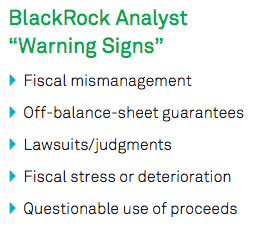
Research Highlights
Suffolk County, NY
BlackRock analysts recognized that, over the past few years, Suffolk County (NY) regularly incurred large structural deficits. As early as 2008, we observed tight coverage on the county’s annual tax anticipation note (TAN) borrowing. On successive issues, the retirement of those notes depended on future borrowings (as opposed to typical coverage from recurring cash receipts), and revenue estimates appeared too optimistic. As fiscal stress became evident, our analysts recommended reducing holdings in Suffolk County. The three rating agencies either put the county on negative outlook or downgraded its credit rating soon after it declared a fiscal emergency in March 2012; BlackRock had already sold Suffolk County general obligation (GO) paper from its high-quality accounts. The breadth and size of our holdings, as well as the coordinated team effort among municipal- only analysts, allows us to efficiently and quickly update and enhance credit research initiated years ago in order to make appropriate, timely investment decisions across all platforms, including money market funds, long-term retail bond funds, institutional accounts and private (single managed) accounts. In addition, several of our analysts saw a parallel between Suffolk County and Nassau County’s fiscal predicament of
the late 1990s and early 2011. BlackRock analysts came to similar, but not identical, credit decisions regarding Nassau County, allowing our portfolio managers to respond appropriately prior to the announced downgrades. In these examples, the experience of our analysts, spanning several decades, allowed us to determine how these situations differed from and were similar to prior periods of fiscal distress.
Collingswood, NJ
In a classic example of a “super downgrade,” Moody’s cut Collingswood’s (NJ) GO bond rating six notches in September 2011—from A1 to a junk-bond rating of Ba1. The sudden, multi-notch downgrade had its roots in the borough’s $4.5 million GO guarantee on an initial $18 million revolving bank loan made to a housing developer during the real estate boom in 2006. With the project significantly underperforming, the developer was unable to reduce the $8.5 million balance to the $4 million required by the lender. Collingswood was left to make good on its guarantee to pay $4.5 million, either by accessing the capital markets or tapping some other unidentified source of capital. The risk that Collingswood could default on the guarantee led to Moody’s deep, sudden downgrade. BlackRock avoided exposure to all Collingswood debt. Our analysts, as early as 2005, had identified the borough’s riskier credit profile, including a high debt burden, reduced borrowing capacity and declining population. The potential exposure to the development project was discussed in the notes to the town’s most recent audit, but the transaction remained essentially an “off-balance-sheet” item. (In the 2010 audit, only $1.3 million was noted as a loan receivable from the developer, but no explanation was given.)
The notes also indicated Collingswood’s foray into other development projects, which BlackRock analysts surmised could potentially signal outsized risks.
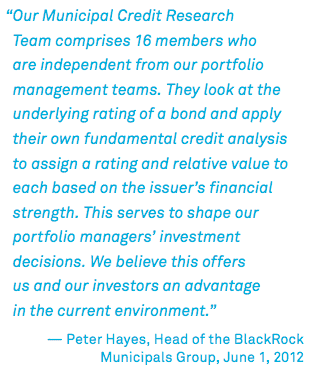
Local Insight, Broad Execution
While their functions are distinct, BlackRock municipal credit analysts work side by side with portfolio managers in a fully integrated process designed to manage risk and generate alpha for clients. Analysts will routinely issue their findings, including ratings and buy/sell recommendations, for consumption by portfolio managers. The analysts assist not only in assessing risk, but in establishing fair pricing for a credit based on its perceived risk/reward, and are evaluated on their accuracy. This type of accountability helps to ensure conviction as well as consistency in the research process.
Likewise, portfolio managers will turn to the research team to ensure that any credit they wish to add to a portfolio is fully analyzed, rated and priced before an investment is made on clients’ behalf. The bottom line: No bond is purchased in a BlackRock municipal portfolio without thorough analysis and approval by the research team.
Given the breadth and depth of our process, and the analysts’ direct access to issuers, BlackRock is able to bypass the red tape that can often exist between rating agencies and municipalities and make informed investment decisions in a timely and opportunistic manner.
Conclusion
BlackRock’s finely tuned credit analysis process is one of the strongest in the industry and boasts a long-term track record of translating that research into investment results. Whereas it can be difficult for individual investors, or even some investment managers, to obtain information on municipal issuers and credits, BlackRock has a well-established footprint in the marketplace that affords us access to information important in investment decision-making.
Going forward, success in the municipal space will depend on careful credit selection. BlackRock’s 16-member Municipal Credit Research team, functioning as an integral part of the broader 40-member BlackRock Municipals team, is charged with conducting the in-depth research required to navigate today’s more complex municipal markets.
Who Is BlackRock?
In a world that is shifting and changing faster than ever before, investors who want answers that unlock opportunity and uncover risk entrust their assets to BlackRock. As an independent, global investment manager, BlackRock has no greater responsibility than to its clients.
It’s why many of the world’s largest pension funds and insurance companies trust BlackRock to understand their unique objectives and why financial advisors and individual end investors partner with BlackRock to help them build the more dynamic, diverse portfolios these times require.
BlackRock has built its offering around its clients’ greatest needs: providing breadth of capabilities—and depth of knowledge—across active and index strategies. This is combined with a singular focus on delivering strong, consistent performance and an ability to look across asset classes, geographies and investment strategies to find the right solutions.
With deep roots in every region across the globe, some 100 investment teams in 27 countries share their best thinking to gain the insights that can change outcomes. And, with a passion to understand risk in all its forms, BlackRock’s 1,000+ risk professionals dig deep to find the numbers behind the numbers and bring clarity to the most daunting financial challenges. That shapes and strengthens the investment decisions that BlackRock—and its clients—are making to deliver better, more consistent returns through time.
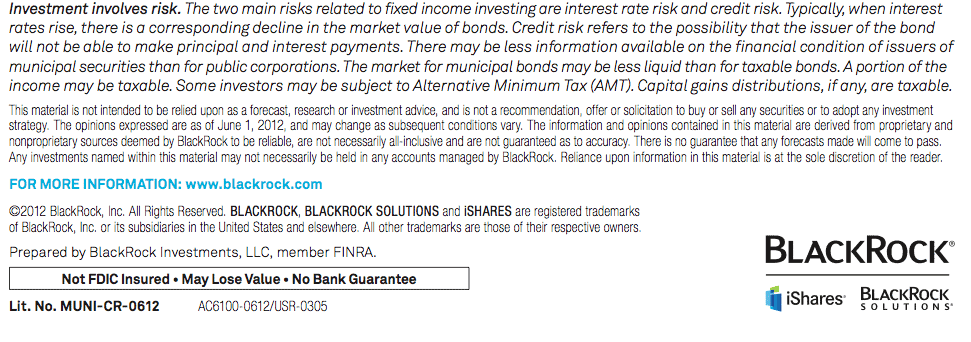
Trusted & Regulated Stock & CFD Brokers
What we like
- 0% Fees on Stocks
- 5000+ Stocks, ETFs and other Markets
- Accepts Paypal Deposits
Min Deposit
$200
Charge per Trade
Zero Commission on real stocks
64 traders signed up today
Visit Now67% of retail investor accounts lose money when trading CFDs with this provider. You should consider whether you can afford to take the high risk of losing your money.
Available Assets
- Total Number of Stocks & Shares5000+
- US Stocks
- German Stocks
- UK Stocks
- European
- ETF Stocks
- IPO
- Funds
- Bonds
- Options
- Futures
- CFDs
- Crypto
Charge per Trade
- FTSE 100 Zero Commission
- NASDAQ Zero Commission
- DAX Zero Commission
- Facebook Zero Commission
- Alphabet Zero Commission
- Tesla Zero Commission
- Apple Zero Commission
- Microsoft Zero Commission
Deposit Method
- Wire Transfer
- Credit Cards
- Bank Account
- Paypall
- Skrill
- Neteller
What we like
- Sign up today and get $5 free
- Fractals Available
- Paypal Available
Min Deposit
$0
Charge per Trade
$1 to $9 PCM
Visit Now
Investing in financial markets carries risk, you have the potential to lose your total investment.
Available Assets
- Total Number of Shares999
- US Stocks
- German Stocks
- UK Stocks
- European Stocks
- EFTs
- IPOs
- Funds
- Bonds
- Options
- Futures
- CFDs
- Crypto
Charge per Trade
- FTSE 100 $1 - $9 per month
- NASDAQ $1 - $9 per month
- DAX $1 - $9 per month
- Facebook $1 - $9 per month
- Alphabet $1 - $9 per month
- Telsa $1 - $9 per month
- Apple $1 - $9 per month
- Microsoft $1 - $9 per month
Deposit Method
- Wire Transfer
- Credit Cards
- Bank Account


